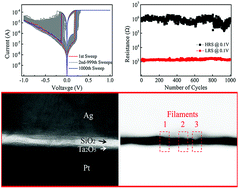SiO2/Ta2O5 heterojunction ECM memristors: physical nature of their low voltage operation with high stability and uniformity†
Abstract
Non-uniformity of switching parameters, e.g., switching voltage and resistances of the high resistance state and low resistance state, could obstruct the practical application of electrochemical metallization cells. Higher switching voltages are also undesirable in terms of power consumption. The non-uniformity is usually related to the number of conductive filaments (CFs) and their degree of dissolution during the RESET process. The number of CFs can be ideally reduced to one by decreasing the device area. However, the degree and location of the dissolution of CFs are difficult to control. Here, we introduce a SiO2/Ta2O5 heterojunction to control the dissolution of CFs, in which the growth direction and the shape of CFs are controlled by the SiO2 layer, while the dissolution of CFs is controlled in the ultrathin Ta2O5 layer. Transmission electron microscopy analysis clearly suggested that the formation/dissolution of CFs occurs in the ultrathin Ta2O5 layer, resulting in low voltage operation (<0.3 V) with high stability and uniformity (Vset distributes in the range smaller than 0.1 V and Vreset distributes in the range smaller than 0.08 V).



 Please wait while we load your content...
Please wait while we load your content...